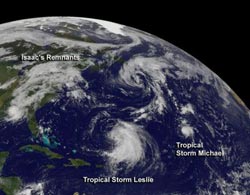Newborn Tropical Storm Michael struggling like Leslie and Isaac

NOAA's GOES-13 satellite captured an image of Isaac's huge blanket of clouds over the US, large Tropical Storm Leslie headed to Bermuda (Leslie is about 400 miles in diameter), and very small Tropical Storm Michael far to the east of Leslie, and located in the central Atlantic. The larger system north of Leslie is a cold-core, low pressure system.<br><br>Credit: NASA GOES Project<br>
Leslie has been a tropical storm since late Aug. and has not yet reached hurricane strength because of wind shear, although that is expected to change. Isaac's remnants are also struggling, but struggling to get off the land and back into the Atlantic Ocean. Isaac's remnants are now associated with a stationary frontal system over the U.S. east coast. The storm made landfall in Louisiana as a hurricane on Aug. 29.
NOAA's GOES-13 satellite captured an image of Isaac's huge blanket of clouds over the U.S., large Tropical Storm Leslie headed to Bermuda (Leslie is about 400 miles in diameter), and very small Tropical Storm Michael far to the east of Leslie, and located in the central Atlantic. Michael is more than seven times smaller than Leslie, as tropical-storm force winds only extend out 35 miles (55 km) from the center, making Michael about 70 miles in diameter. The image was created by the NASA GOES Project at NASA Goddard Space Flight Center in Greenbelt, Md.
On Sept. 4 at 11 a.m. EDT, Michael's maximum sustained winds were near 40 mph (65 kmh). Michael was located about 1,220 miles (1,965 km) southwest of the Azores, near latitude 27.0 north and longitude 43.5 west. Michael is moving toward the north-northwest near 5 mph (7 kmh) and expected to move more toward the north in the next couple of days while not strengthening much, according to the National Hurricane Center.
According to NOAA's Hydrometeorological Prediction Center, most of the remnants of Tropical cyclone Isaac are now part of an elongated center of low pressure over the Alabama-Georgia border that is spreading clouds and showers along the U.S. east coast. That center is expected to move south of south-southwest while an upper level low pressure area near Miami moves north-northwestward.
Media Contact
More Information:
http://www.nasa.govAll latest news from the category: Earth Sciences
Earth Sciences (also referred to as Geosciences), which deals with basic issues surrounding our planet, plays a vital role in the area of energy and raw materials supply.
Earth Sciences comprises subjects such as geology, geography, geological informatics, paleontology, mineralogy, petrography, crystallography, geophysics, geodesy, glaciology, cartography, photogrammetry, meteorology and seismology, early-warning systems, earthquake research and polar research.
Newest articles

Sea slugs inspire highly stretchable biomedical sensor
USC Viterbi School of Engineering researcher Hangbo Zhao presents findings on highly stretchable and customizable microneedles for application in fields including neuroscience, tissue engineering, and wearable bioelectronics. The revolution in…

Twisting and binding matter waves with photons in a cavity
Precisely measuring the energy states of individual atoms has been a historical challenge for physicists due to atomic recoil. When an atom interacts with a photon, the atom “recoils” in…

Nanotubes, nanoparticles, and antibodies detect tiny amounts of fentanyl
New sensor is six orders of magnitude more sensitive than the next best thing. A research team at Pitt led by Alexander Star, a chemistry professor in the Kenneth P. Dietrich…





















